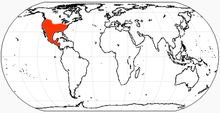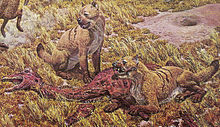- Borophagus
-
Borophagus[1]
Temporal range: late Miocene to late Pliocene
Osteoborus cyonoides skull Scientific classification Kingdom: Animalia Phylum: Chordata Class: Mammalia Order: Carnivora Family: Canidae Subfamily: †Borophaginae Genus: †Borophagus
Cope, 1892Type species †Borophagus diversidens Species - †B. diversidens
- †B. dudleyi
- †B. hilli
- †B. littoralis
- †B. orc
- †B. parvus
- †B. pugnator
- †B. secundus

Range of Borophagus based on fossil distribution Synonyms Borophagus ("gluttonous eater") is an extinct genus of the subfamily Borophaginae, a group of canids endemic to North America from the early Miocene epoch through the Zanclean stage of the Pliocene epoch 23.3—3.6 Mya. Borophagus existed for approximately 19.7 million years.[2]
Contents
Overview
Borophagus, like other borophagines, are loosely known as "bone-crushing" or "hyena-like" dogs. Though not the most massive borophagine by size or weight, it had a more highly-evolved capacity to crunch bone than earlier, larger genera such as Epicyon, which seems to be an evolutionary trend of the group (Turner, 2004). During the Pliocene epoch, Borophagus began being displaced by Canis genera such as Canis edwardii and later by Canis dirus. Early species of Borophagus were placed in the genus Osteoborus until recently, but the genera are now considered synonyms.[1] Borophagus possibly led a hyena-like lifestyle scavenging carcasses of recently dead animals.
Canidae competitors
Borophagus was one of the last Borophaginae and would have shared its North American habitat with other canidae: Epicyon ((20.6—5.330 Ma), Paratomarctus (16.3—5.3 Ma), Carpocyon (20.4—3.9 Ma), Aelurodon (23.03—4.9 Ma), and the first emerging wolf, Canis lepophagus appearing 10.3 Ma.
Taxonomy
Typical features of this genus are a bulging forehead and powerful jaws; it was probably a scavenger.[3] Its crushing premolar teeth and strong jaw muscles would have been used to crack open bone, much like the hyena of the Old World. The adult animal is estimated to have been about 80 cm in length, similar to a coyote, although it was much more powerfully built.[4]
Morphology
Two fossil specimens of Borophagus were measured by Legendre and Roth in 1988. They estimated that specimen one weighed 43.8 kilograms (97 lb) and the second weighed 35.8 kilograms (79 lb).[5]
Species
- Borophagus diversidens existed for 3.1 million years (synonymous with Felis hillianus, Hyaenognathus matthewi, Hyaenognathus pachyodon, Hyaenognathus solus, Porthocyon dubius)
- Borophagus dudleyi existed for 19.7 million years
- Borophagus hilli existed for 19.7 million years (synonymous with Osteoborus crassapineatus, Osteoborus progressus)
- Borophagus littoralis existed for 13 million years (syn. Osteoborus diabloensis)
- Borophagus orc existed for 5.4 million years
- Borophagus parvus existed for 6.4 million years
- Borophagus pugnator existed for 18 million years (synonymous with Osteoborus galushai)
- Borophagus secundus existed for 18 million years (synonymous with Hyaenognathus cyonoides, Hyaenognathus direptor)
Existence based on age of fossil collections and recombination with other species.
Sister genera
Carpocyon, Epicyon, Paratomarctus, Protepicyon
References
- ^ a b Wang, Xiaoming; Richard Tedford, Beryl Taylor (1999-11-17). "Phylogenetic systematics of the Borophaginae". Bulletin of the American Museum of Natural History 243. http://www.nhm.org/expeditions/rrc/wang/documents/Wangetal1999borophaginemonographpart1.pdf. Retrieved 2007-07-08.[dead link]
- ^ PaleoBiology Database: Borophagus, basic info
- ^ Lambert, David (1985). The Field Guide to Prehistoric Life. New York: Facts on File. p. 163. ISBN 0-8160-1125-7.
- ^ Palmer, D., ed (1999). The Marshall Illustrated Encyclopedia of Dinosaurs and Prehistoric Animals. London: Marshall Editions. p. 220. ISBN 1-84028-152-9.
- ^ S. Legendre and C. Roth. 1988. Correlation of carnassial tooth size and body weight in recent carnivores (Mammalia). Historical Biology: p. 85-98
- Alan Turner, "National Geographic: Prehistoric Mammals" (Washington, D.C.: Firecrest Books Ltd., 2004), pp. 112-114. ISBN 0-7922-7134-3
- Xiaoming Wang, "The Origin and Evolution of the Dog Family" Accessed 1/30/06.
Further reading
- Xiaoming Wang, Richard H. Tedford, Mauricio Antón, Dogs: Their Fossil Relatives and Evolutionary History, New York : Columbia University Press, 2008; ISBN 978-0-231-13528-3
Extinct members of the family Canidae †Hesperocyoninae Hesperocyon · Mesocyon · Cynodesmus · Sunkahetanka · Philotrox · Enhydrocyon · Paraenhydrocyon · Osbornodon · Caedocyon · EctopocynusBorophaginae Archaeocyon · Borophagina · Borophagini · Oxetocyon · Otarocyon · Rhizocyon · Cynarctoides · Phlaocyon · Cormocyon · Desmocyon · Metatomarctus · Euoplocyon · Psalidocyon · Microtomarctus · Protomarctus · Tephrocyon · Paracynarctus · Cynarctus · Tomarctus · Aelurodon · Paratomarctus · Carpocyon · Protepicyon · Epicyon · BorophagusCaninae
(extinct genera)Chailicyon · Cynotherium · Dusicyon · Eucyon · Gobicyon · Leptocyon · Neocynodesmus · Nurocyon · Prototocyon · Theriodictis · XenocyonCaninae
(extinct species and subspecies)Canis apolloniensis · Canis armbrusteri · Canis cedazoensis · Canis dirus · Canis edwardii · Canis ferox · Canis lepophagus · Canis lupus hattai · Canis lupus hodophilax · Urocyon progressusCategoryCategories:- Borophagines
- Miocene mammals
- Pliocene mammals
- Prehistoric mammals of North America
Wikimedia Foundation. 2010.

